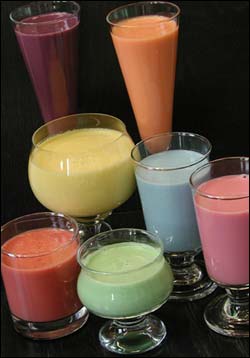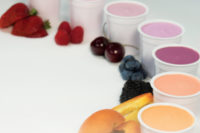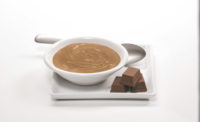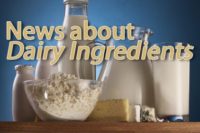
Let’s look at a typical scenario for a product developer. After a meeting with marketing, the product developer’s new project entails developing a dairy-based product with the following requirements: Pasteurization, stable strawberry color, kosher status and vegetarian friendly.
Let’s begin by examining the possible colors available for use in this type of product. The natural colors, which are available today, can be derived from a wide variety of raw materials, allowing one to achieve the desired color hue and labeling requirements.
Examples of some raw materials that could impart a strawberry color include:
Carmine—Various forms of carmine impart a nice light pink to red hue in dairy products. However, this particular product would not work for this product developer’s project since it is not kosher and would be non-vegetarian. Carmine is the calcium or aluminum lake of carminic acid, which is extracted from the bodies of the female cochineal insect (Dactylopius coccus).
Beet juice—Although beet juice gives a nice strawberry color, its performance is often unsatisfactory under most conditions such as heating and light exposure, when it typically fades and no longer imparts strawberry color.
Red anthocyanin-based and yellow-orange carotenoid-based colors derived from fruits and vegetables can achieve a nice strawberry color with the best stability to heat and light while also having kosher status.
Anthocyanins—Pinks, reds and purples derived from fruits and vegetables such as elderberries, chokeberries or carrots are dependent on pH, shifting color hues from pinks and reds at pH 3.0 to purple-violets at pH 5.0 and blues at pH 7.0.
Carotenoids—Yellows and oranges derived from fruits and vegetables such as carrots or pumpkins are independent of pH and provide the same color shade in all application types.
Product specific color selection
Since technical concerns are closely related to the type of product you are developing, let’s examine two different products with different technical concerns.With fruit-on-the-bottom yogurt, there exists a technical challenge because of the shift in pH between the white mass and the fruit preparation. Knowing the pH of your product is the key to choosing the most applicable color and to achieving the correct color shade. The pH gradient between the fruit preparation (pH 3.0) and the yogurt (pH 4.5) could cause a color change in anthocyanin-based colorants. An advantage of a color shift in such a system could be that when red colored fruit is stirred into uncolored yogurt, the product takes on desirable purple tones. The color in the fruit preparation could also be adjusted so that when stirred in, the desired color shade is achieved.
Undesirable color hues due to pH shifts can be avoided by using a different raw material. For example, if you added some carotenoid-based yellow colorants with anthocyanin-based red colorants, an excellent strawberry color shade can be achieved. Since each colorant derived from the various raw materials behaves differently, it is crucial to find behaviors that will best suit your application.
With Swiss-style yogurt, the technical concern is obtaining and maintaining the correct color shade throughout shelflife. Knowing the processing and storage parameters of your product and how your colorant will behave in certain conditions is important when ensuring the colorant you use is still present when the consumer eats your product.
As mentioned, beet juice, which provides a nice red color hue at slightly higher pH will undergo severe color loss when exposed to heat. Certain vegetable juice products, however, are extremely resilient and provide excellent color stability under both heating processes and freeze-thaw cycles.
While natural colorants offer increasing benefits and become less restrictive than artificial colors, they are also becoming more cost effective. Natural colors are usually very concentrated, resulting in low dosage levels (0.1-0.5 %) with no effect on texture or flavor. If desired, the colors can even be unitized with the flavors or incorporated into the fruit preparations. Natural colorants in dairy products are also very stable to heat and light with excellent shelflife stability.





